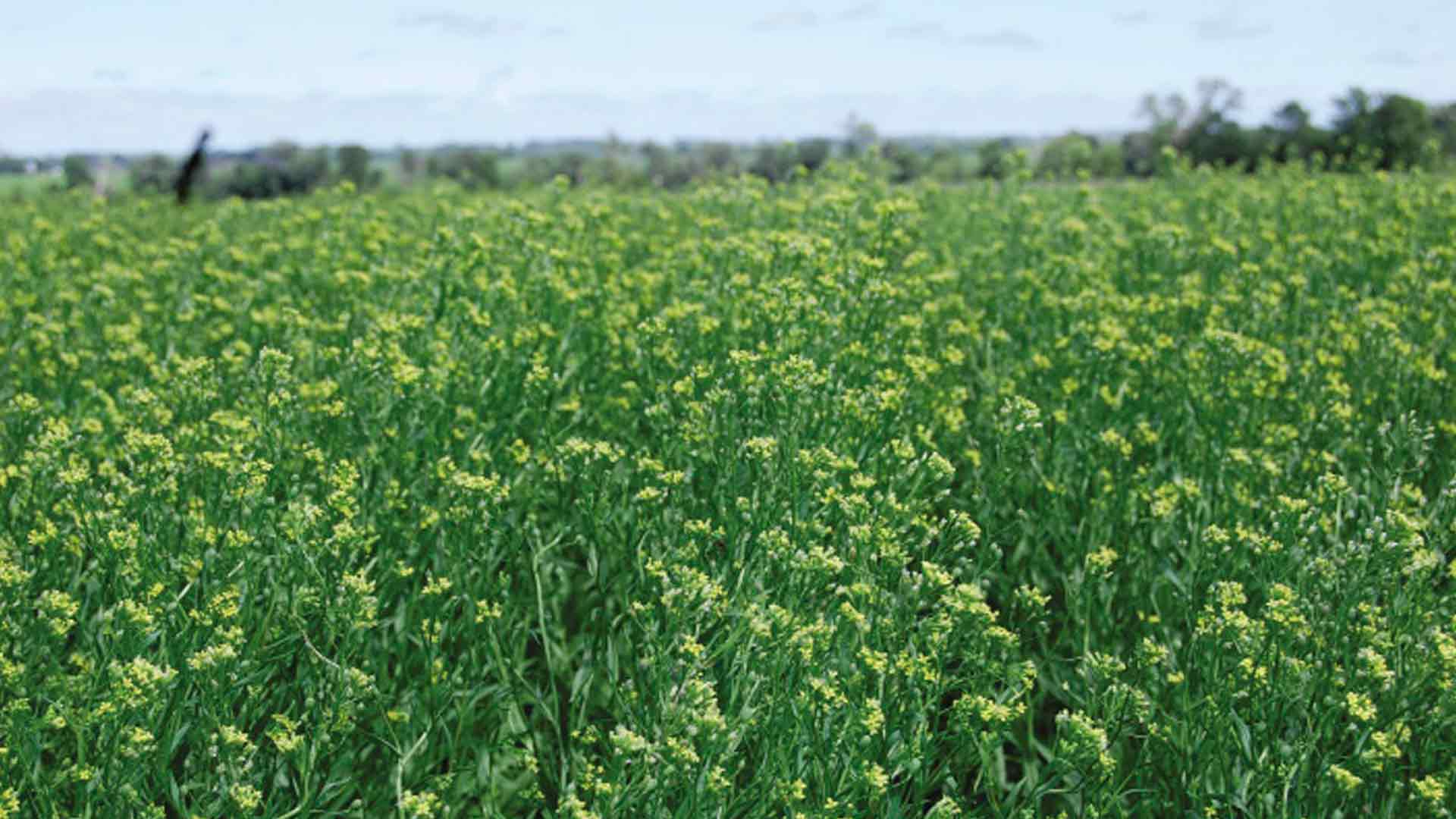–by Dan Lemke
Introducing a new crop to Minnesota isn’t easy. A wide range of plants can grow in the state’s fertile soils, but crops also need to deliver value before farmers will plant them. AURI researchers and scientists at the University of Minnesota are taking a closer look at two crops that show promise to produce both added revenue and environmental benefits.
Pennycress is in the mustard family. Similar to canola, it produces small seeds in flat pods. The seeds can be pressed to produce oil. It’s native to the Mediterranean region of Europe and Asia, but was reportedly grown in the United States as far back as the 1700s.
Camelina is sometimes known as false flax. It too, is an oilseed crop, generating oil that can be used for food or industrial purposes.
Pennycress and camelina are garnering attention because of their potential to be grown in relay with the state’s staple crops, such as corn, soybeans or sugar beets. Because they are winter annuals, camelina and pennycress can be planted in the fall immediately after primary crops are harvested.
Relay crops overlap with the growing seasons of primary crops. Both plant varieties establish quickly and are winter hardy, greening up again early in the spring. Crops like sugar beets or soybeans can be planted directly into the pennycress or camelina stands. The relay crops are harvested in the spring, typically by mid-June, before negatively impacting the development of primary crops.
Keeping it green
AURI Senior Director of Science & Technology Rod Larkins says satellite images of Minnesota show that most farmland is only green from May through August. The rest of the time fields are mainly brown or black.
“Minnesota’s current crop production systems are dominated by summer annual crops that only provide complete living cover of Minnesota’s agricultural landscape for three months during the summer, leaving the land bare and brown for nine months of the year. Without active plant root systems to hold the soil in place and absorb water, fields are vulnerable to wind and water erosion, and nutrient leaching,” said Don Wyse, co-director of the Forever Green Initiative.
The Forever Green Initiative is part of the University of Minnesota’s Center for Integrated Natural Resources and Agricultural Management. Wyse says the Initiative is working toward the next generation of crops, specifically winter annuals and perennials, that can fill the so-called “brown period.”
“We are interested in pennycress and camelina because we’re not looking at plants that just fill the brown period, but crops that have economic opportunity for farmers,” Wyse says.
Cover crops are gaining traction in the Midwest as a way to reduce erosion and promote soil health. In most cases, the cover crops themselves have little economic value, though some farmers graze cattle on the cover crops for winter forage. Relay crops like camelina and pennycress offer environmental benefits with the potential for an accompanying economic boost.
“We are trying to take advantage of the world’s need for a wide range of products including green energy and biobased products by linking them to Minnesota agriculture so farmers can take advantage,” says Nick Jordan, co-director of the Forever Green Initiative and U of M professor. “We want to grow the total pie of agricultural production by growing crops that supplement and complement summer annuals.”
Wyse says pennycress and camelina cultivars have been developed that will grow and thrive in Minnesota’s climate. The specific varieties that will be planted will depend on where market opportunities emerge.
Identifying uses
While both plants can be grown here, success will depend upon uses for the crops. AURI is part of a group working to determine the feasibility of incorporating pennycress and camelina into a relay system. Among AURI’s roles is the identification of uses, and market opportunities for the crops and determining a value for the meal and oil.
“Jet fuel is one very enticing possibility from the oil,” Larkins says. “The meal can be used for animal feed, but there is also potential for extracting higher-value chemicals.”
Both camelina and pennycress could provide sustainable sources for biofuels like biodiesel. Camelina seeds contain 35 to 38 percent oil and are high in omega-3 fatty acids, which makes the oil fit for biofuels production and the meal an option for livestock feed.
AURI and partnering organizations convened several meetings with farm groups to share the concept. While there is interest among groups and some entrepreneurs, hurdles must be cleared before pennycress and camelina appear across the landscape.
“We need a stable supply, a stable demand and the infrastructure to handle the crops,” Jordan says. “We’re looking for innovation in systems, innovation in marketing and innovation in the supply chain. We are trying to carry that out in a coordinated way.”
Larkins says processing looks to be fairly straight forward with the oil extracted from the seeds similar to canola processing.
In addition to working as potential relay crops, pennycress and camelina could provide environmental benefits. Established stands should help reduce soil erosion, protect water quality and provide habitat for wildlife and pollinators.
“These crops provide potential options to achieve conservation results and a way to make money in the process,” adds Larkins.
Larkins acknowledges it could take five years or more to get all the pieces in place, including agronomic details, processing logistics and the identification of uses and markets. If those factors are addressed and pennycress and camelina show economic viability, growers are likely to give them a try.
“If we can show it’s profitable, farmers will be interested,” Wyse says.
Podcast: Play in new window | Download (939.1KB) | Embed
